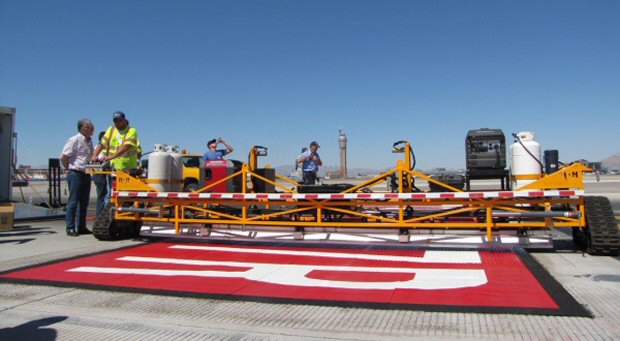FAA Freezes Preformed Thermoplastic
By Mike Speidel
![]()
 On August 9, 2016, a memo was sent from FAA headquarters in Washington, DC to all of its Regional Airport Division Managers. The memo was passed on to
Airport Certification Safety Inspectors, who then distributed it to their respective networks of Part 139 Airports. The subject: Preformed Thermoplastic
Airport Pavement Markings. I'm going to summarize what it said; to read a PDF version, click the image to the right.
On August 9, 2016, a memo was sent from FAA headquarters in Washington, DC to all of its Regional Airport Division Managers. The memo was passed on to
Airport Certification Safety Inspectors, who then distributed it to their respective networks of Part 139 Airports. The subject: Preformed Thermoplastic
Airport Pavement Markings. I'm going to summarize what it said; to read a PDF version, click the image to the right.
Summary of FAA Memo
The FAA has received feedback from a few airports that preformed thermoplastic markings have not met expected life cycles. Additionally, based on its experiences, a manufacturer has recommended excluding the use of preformed thermoplastic in very specific instances. The FAA Technical Center is currently studying the durability of paint and beads, and the viability of a water-based structured methacrylate and preformed thermoplastic. Federal funding will be suspended for preformed thermoplastic markings at least until the FAA Technical Center's study is completed.
By now you've probably heard about this memo, or at least a version of it as it travels through the industry like a game of telephone. Speaking of which, my phone began to ring off the hook on August 9th with all kinds of questions about what the memo meant. I'm hoping to bring some clarity as to where preformed thermoplastic stands today, because this situation is still evolving. So here it goes...

AirMark In Time
A little background: In 2009, preformed thermoplastic was approved for use on airfields in the FAA Advisory Circular 150/5370-10E. The AC required specialized equipment and certified applicators to install the material. Since, the use of preformed thermoplastic has been specified and applied in countless airfield construction projects at airports of every size. The cost of the material is greater than traditional waterborne paints, however its durability can justify the higher initial investment. AirMark, originally manufactured by Flint Trading (now Ennis-Flint), was designed specifically for use on airfields. To my knowledge, Ennis-Flint remains the only manufacturer of preformed thermoplastics for airfields.
Cash Or Thermoplastic?
I have heard several airports' interpretations of what the memo meant - everything from "We have to remove it all!" to "Will we be written up by our inspector?" The only thing I can be sure of from the memo is the FAA will not fund any more preformed thermoplastic until conclusions are made of the durability study; I don't know how long the study may last. In the meantime, it appears you may be able to use it as you normally would, provided you're paying for it.
More Marking Memos
You can probably imagine how the FAA's memo went over with the manufacturer, Ennis-Flint. The memo was unexpected as they had no knowledge of it before you or I did. Since, they have responded with a couple memos of their own; one to the FAA, and another to its network of AirMark Certified Applicators. The memo in response to the FAA included the following:
- A request for an amendment or addendum to the original memo.
- Clarified that the recommendation to exclude the use of preformed thermoplastic was specific to one airport, and was not indicative of its performance anywhere else.
- Noted all material approved applicators are trained and qualified to ensure quality.
- Noted the negative impact the original memo has had and could have on their business and an effective traffic safety solution.
- A request for an in-person, follow-up meeting at FAA headquarters.
A follow-up meeting between the manufacturer and FAA was held this past Friday, September 23. Assuming anything changes as a result of that meeting, we will keep you updated with any new information.
While it's important to constantly evaluate marking performance in the field, I may have handled this situation another way. Admittedly, I do not know all the details, however, in my humble opinion, relying on data from "a few airports" to dictate what is permitted for 500+ airports seems hasty. I have seen countless issues with all of the approved materials (peeling paint, anyone?), yet they continue to be eligible for federal funds.
Jump to another article:
Back to Newsletter | FAA Freezes Preformed Thermoplastic | UFGS 32 17 23 | Natural Consequences | What's New?
